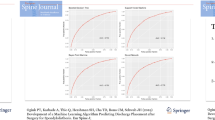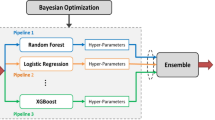Abstract
Purpose
By predicting short-term postoperative outcomes before surgery, patients undergoing cervical laminoplasty (CLP) surgery could benefit from more accurate patient care strategies that could reduce the likelihood of adverse outcomes. With this study, we developed a series of machine learning (ML) models for predicting short-term postoperative outcomes and integrated them into an open-source online application.
Methods
National surgical quality improvement program database was utilized to identify individuals who have undergone CLP surgery. The investigated outcomes were prolonged length of stay (LOS), non-home discharges, 30-day readmissions, unplanned reoperations, and major complications. ML models were developed and implemented on a website to predict these three outcomes.
Results
A total of 1740 patients that underwent CLP were included in the analysis. Performance evaluation indicated that the top-performing models for each outcome were the models built with TabPFN and LightGBM algorithms. The TabPFN models yielded AUROCs of 0.830, 0.847, and 0.858 in predicting non-home discharges, unplanned reoperations, and major complications, respectively. The LightGBM models yielded AUROCs of 0.812 and 0.817 in predicting prolonged LOS, and 30-day readmissions, respectively.
Conclusion
The potential of ML approaches to predict postoperative outcomes following spine surgery is significant. As the volume of data in spine surgery continues to increase, the development of predictive models as clinically relevant decision-making tools could significantly improve risk assessment and prognosis. Here, we present an accessible predictive model for predicting short-term postoperative outcomes following CLP intended to achieve the stated objectives.




Similar content being viewed by others
Data availability
Restrictions apply to the availability of these data. Data were obtained from American College of Surgeons National Surgical Quality Improvement Program and are available (https://www.facs.org/quality-programs/data-and-registries/acs-nsqip/) with the permission of American College of Surgeons.
Code availability
The source code for preprocessing and analyzing the data is available on GitHub (https://github.com/mertkarabacak/NSQIP-CLP).
References
Nouri A, Tetreault L, Singh A et al (2015) Degenerative cervical myelopathy: epidemiology, genetics, and pathogenesis. Spine 40:E675–E693. https://doi.org/10.1097/BRS.0000000000000913
Adogwa O, Huang K, Hazzard M et al (2015) Outcomes after cervical laminectomy with instrumented fusion versus expansile laminoplasty: a propensity matched study of 3185 patients. J Clin Neurosci 22:549–553. https://doi.org/10.1016/j.jocn.2014.10.001
Liu X, Wang H, Zhou Z, Jin A (2014) Anterior decompression and fusion versus posterior laminoplasty for multilevel cervical compressive myelopathy. Orthopedics. https://doi.org/10.3928/01477447-20140124-12
Veeravagu A, Azad TD, Zhang M et al (2018) Outcomes of cervical laminoplasty—population-level analysis of a national longitudinal database. J Clin Neurosci 48:66–70. https://doi.org/10.1016/j.jocn.2017.10.089
Duetzmann S, Cole T, Ratliff JK (2015) Cervical laminoplasty developments and trends, 2003–2013: a systematic review. J Neurosurg Spine 23:24–34. https://doi.org/10.3171/2014.11.SPINE14427
Kim JS, Merrill RK, Arvind V et al (2018) Examining the ability of artificial neural networks machine learning models to accurately predict complications following posterior lumbar spine fusion. Spine 43:853–860. https://doi.org/10.1097/BRS.0000000000002442
Khuri SF, Henderson WG, Daley J et al (2007) The patient safety in surgery study: background, study design, and patient populations. J Am Coll Surg 204:1089–1102. https://doi.org/10.1016/j.jamcollsurg.2007.03.028
About ACS NSQIP. In: ACS. https://www.facs.org/quality-programs/data-and-registries/acs-nsqip/about-acs-nsqip/. Accessed 29 Sep 2022
Collins GS, Reitsma JB, Altman DG, Moons K (2015) Transparent reporting of a multivariable prediction model for individual prognosis or diagnosis (TRIPOD): the TRIPOD statement. BMC Med 13:1. https://doi.org/10.1186/s12916-014-0241-z
Luo W, Phung D, Tran T et al (2016) Guidelines for developing and reporting machine learning predictive models in biomedical research: a multidisciplinary view. J Med Internet Res 18:e323. https://doi.org/10.2196/jmir.5870
Akiba T, Sano S, Yanase T, et al (2019) Optuna: A Next-generation Hyperparameter Optimization Framework
Hanley JA, McNeil BJ (1982) The meaning and use of the area under a receiver operating characteristic (ROC) curve. Radiology 143:29–36. https://doi.org/10.1148/radiology.143.1.7063747
Feng Y, Zhou M, Tong X (2021) Imbalanced classification: a paradigm-based review. Stat Anal Data Min ASA Data Sci J 14:383–406. https://doi.org/10.1002/sam.11538
Mullick SS, Datta S, Dhekane SG, Das S (2020) Appropriateness of performance indices for imbalanced data classification: an analysis. Pattern Recogn. https://doi.org/10.48550/ARXIV.2008.11752
Galar M, Fernandez A, Barrenechea E et al (2012) A review on ensembles for the class imbalance problem: bagging-, boosting-, and hybrid-based approaches. IEEE Trans Syst Man Cybern Part C Appl Rev 42:463–484. https://doi.org/10.1109/TSMCC.2011.2161285
Saito T, Rehmsmeier M (2015) The precision-recall plot is more informative than the ROC plot when evaluating binary classifiers on imbalanced datasets. PLoS ONE 10:e0118432. https://doi.org/10.1371/journal.pone.0118432
Van Calster B, McLernon DJ et al (2019) Calibration: the achilles heel of predictive analytics. BMC Med 17:230. https://doi.org/10.1186/s12916-019-1466-7
Niculescu-Mizil A, Caruana R (2005) Predicting good probabilities with supervised learning. In: Proceedings of the 22nd international conference on Machine learning - ICML ’05. ACM Press, Bonn, Germany, pp 625–632
Lopez CD, Boddapati V, Lombardi JM et al (2022) Artificial learning and machine learning applications in spine surgery: a systematic review. Glob Spine J 12:1561–1572. https://doi.org/10.1177/21925682211049164
Leu S, Kamenova M, Mehrkens A et al (2016) Preoperative and postoperative factors and laboratory values predicting outcome in patients undergoing lumbar fusion surgery. World Neurosurg 92:323–338. https://doi.org/10.1016/j.wneu.2016.05.011
Phan K, Dunn AE, Kim JS et al (2017) Impact of preoperative anemia on outcomes in adults undergoing elective posterior cervical fusion. Glob Spine J 7:787–793. https://doi.org/10.1177/2192568217705654
Phan K, Wang N, Kim JS et al (2017) Effect of preoperative anemia on the outcomes of anterior cervical discectomy and fusion. Glob Spine J 7:441–447. https://doi.org/10.1177/2192568217699404
Rolston JD, Han SJ, Chang EF (2017) Systemic inaccuracies in the national surgical quality improvement program database: implications for accuracy and validity for neurosurgery outcomes research. J Clin Neurosci Off J Neurosurg Soc Australas 37:44–47. https://doi.org/10.1016/j.jocn.2016.10.045
Author information
Authors and Affiliations
Contributions
Conceptualization, MK and KM; methodology, MK and KM; software, MK; formal analysis, MK; data curation, MK; writing—original draft preparation, MK; writing—review and editing, KM; visualization, MK; supervision, KM; project administration, MK and KM.
Corresponding author
Ethics declarations
Conflict of interest
The authors declare no conflict of interest.
Statement by ACS
The American College of Surgeons National Surgical Quality Improvement Program and the hospitals participating in the ACS NSQIP are the source of the data used herein; they have not verified and are not responsible for the statistical validity of the data analysis or the conclusions derived by the authors.
Institutional review board statement
This study was deemed exempt from approval by the Icahn School of Medicine at Mount Sinai institutional review board because it involved analysis of deidentified patient data.
Additional information
Publisher's Note
Springer Nature remains neutral with regard to jurisdictional claims in published maps and institutional affiliations.
Supplementary Information
Below is the link to the electronic supplementary material.
Rights and permissions
Springer Nature or its licensor (e.g. a society or other partner) holds exclusive rights to this article under a publishing agreement with the author(s) or other rightsholder(s); author self-archiving of the accepted manuscript version of this article is solely governed by the terms of such publishing agreement and applicable law.
About this article
Cite this article
Karabacak, M., Margetis, K. Development of personalized machine learning-based prediction models for short-term postoperative outcomes in patients undergoing cervical laminoplasty. Eur Spine J 32, 3857–3867 (2023). https://doi.org/10.1007/s00586-023-07923-x
Received:
Revised:
Accepted:
Published:
Issue Date:
DOI: https://doi.org/10.1007/s00586-023-07923-x




